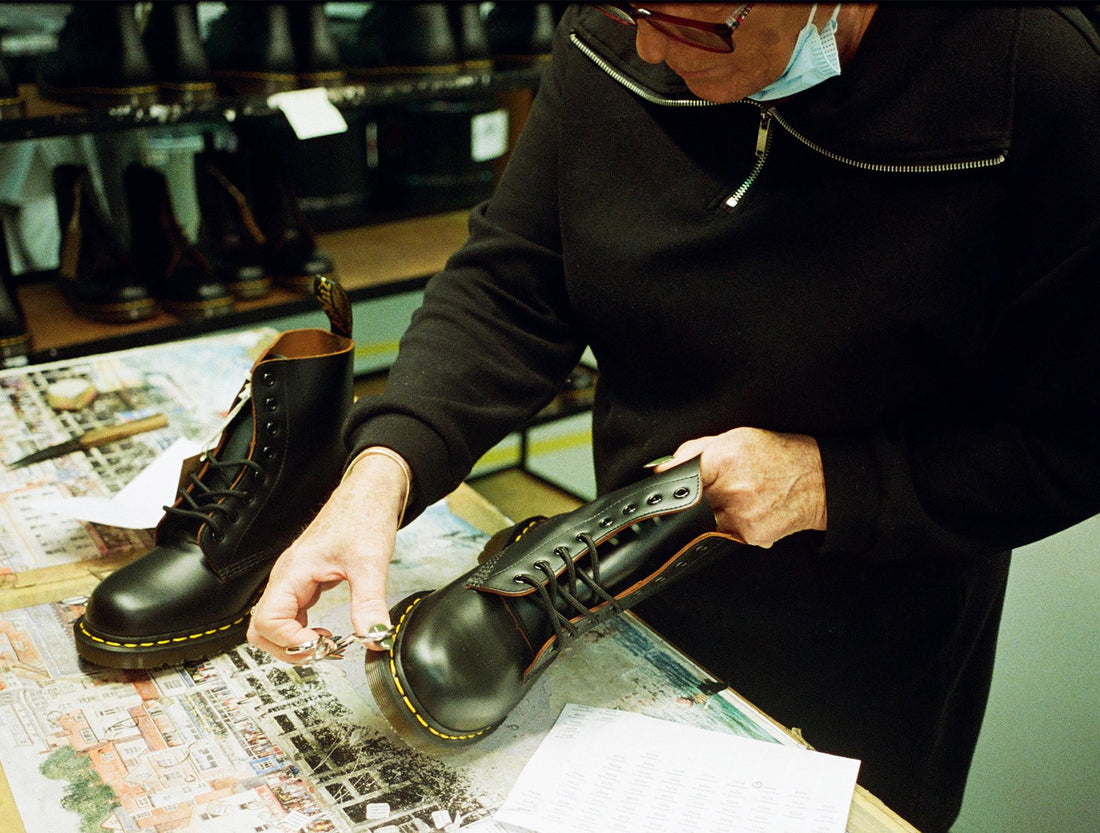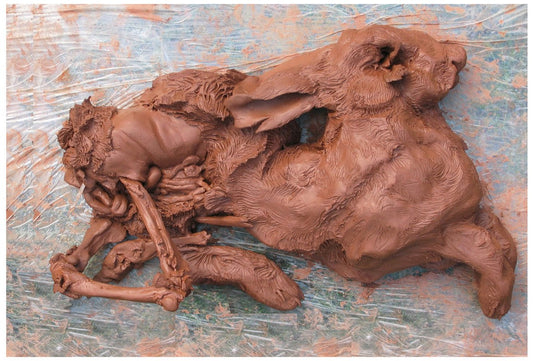When asked to picture a combat boot, what do you see? If you’re visualizing a black leather boot with a chunky rubber sole and distinct yellow stitching all the way around, you’re undoubtedly thinking of the iconic Dr. Martens original 1460 boot. Dr. Martens has established itself as a household name for generations, with its unmistakable design and far-reaching cultural impact.
With a history spanning over 70 years, it’s no surprise that the evolution of Dr. Martens combat boots has been so extensively covered. Throughout the decades, various alternative subcultures have incorporated Dr. Martens into their identities, proving the brand’s philosophy that those who wear them are “people who have their own individual style but share a united spirit – authentic characters who stand for something.”

Wartime Origins (1940s-1960s)
The origins of Dr. Martens combat boot (also called DMs or simply Docs) all began in post-war Germany in 1945. Then-25-year-old German Army doctor Klaus Maertens, nursing a broken foot, found that his army-issued combat boots were too uncomfortable. He decided to create a pair of combat boots with air-cushioned soles instead of the traditional leather soles combat boots typically featured. Maertens showed the design to his university friend and mechanical engineer, Dr. Herbert Funk. He loved the design, and formal production of the boots began in 1947.
By 1959, after over a decade of success, the two decided it was time to advertise their shoes overseas. In 1960, back in England, Klaus Maertens’ shoes were acquired by the Griggs company, which was well-established in the English footwear industry. The Griggs company made some critical changes to Klaus Maertens' original design, including “an altered heel, a bulbous but simple upper, a distinctive yellow welt stitch, a two-tone grooved sole edge, and a unique sole pattern,” according to Dr. Martens official history of the brand. This was the birth of the 1460 eight-hole boot, the style number a reference to the date of the boot’s inception: April 1, 1960.
During the early days of Dr. Martens in the 60s, they were typically worn by the UK’s working class—postal workers, police officers, and factory workers. Staying true to their original purpose as a work boot, Dr. Martens served the working class well. They were affordable and durable enough to withstand the daily physical labor of blue-collar workers.
Thanks to the working class, Dr. Martens took off in a way Klaus Maerten could never have anticipated: the boots were picked up by “early multicultural, ska-loving skinheads.” This was the start of the adoption of Dr. Martens by various alternative subcultures and groups into their fashion identity, something that the brand’s 70-year history has relied upon.

The Working Class and Subcultural Style (1970s-1990s)
Beginning in the 70s, Dr. Martens began making huge waves with those in the UK punk subculture. During this time, the cherry-red 14-hole boots often donned by young punks throughout the country became just as recognizable as the original black eight-hole ones. Those who ascribed themselves to the punk subculture were often working-class, and the punk scene “was defined by identity crises of working-class members of society,” according to Indie Mag.
Other subcultures caught wind of the newest chunky boots on the market and enveloped them into their fashion styles and identities as well. One such subculture, also originating in the UK, was the skinheads. Originally, skinheads, like punks, aligned themselves with the working class and felt empowered by their social alienation. Over time, though, several offshoots of skinhead culture became prevalent, forming neo-Nazi and white power groups. This violent, racist group of skinheads also frequently wore Dr. Martens, creating confusion around the term “skinhead” and its working-class origins.
Because of this confusion, Dr. Martens could no longer be used as a catch-all identification marker for all skinheads. To differentiate themselves from the neo-Nazi skinheads (and vice versa), some skinheads began to swap out the original black laces that came with each Dr. Martens pair for colored ones that each had a specific meaning according to “lace code.” However, there is no definitive guide for which colors mean what, as the meanings varied between subculture groups, some lace colors could confidently be ascribed to certain ideals—such as white signifying white supremacy and yellow for anti-racism.
Fascinatingly, Dr. Martens was the one connecting thread between subculture groups on complete opposite ends of the political spectrum. Both radical neo-Nazis and leftist anti-fascists have historically worn Dr. Martens to set themselves apart from the crowd. How could one pair of combat boots appeal to two wildly different groups of people? It’s difficult to say for certain, but it’s clear that Dr. Martens retained a unique ability to attract those who distanced themselves from mainstream culture and existed on the fringes of society.

Dr. Martens wouldn’t stay confined within subcultures forever, though. One of the first celebrities to wear Dr. Martens was Pete Townshend, the guitarist for the beloved rock band The Who, in 1964. This was also the first instance where Dr. Martens and music became inextricably linked with one another—a relationship that would continue from the 70s onward. In fact, in the 80s and 90s, as Dr. Martens gained newfound popularity in the U.S., they became an integral component of grunge and emo fashion. The chunkiness of the soles and durability of the leather favored them among concert-goers who often found themselves in rowdy, tightly-packed venues, thrashing about in mosh pits.
At the same time, Dr. Martens bore significance to another subculture enduring fierce discrimination: the LGBTQ+ community. During the beginnings of the queer liberation movement, gays and lesbians needed a covert way to visually identify one another, much like the skinheads in the UK. The answer? Dr. Martens. Butch lesbians particularly enjoyed the comfort of Dr. Martens, as they often worked non-traditional, physically demanding jobs that were typically done by men. This helped to shape queer fashion and culture into what it is now, with Dr. Martens still being a favorite among LGBTQ+ individuals today.
As the 90s grunge scene transitioned into 2000s emo, Dr. Martens were still being championed by those who felt outcast, alienated, or different from everyone else.
A Shoe For Everyone, Everywhere (2000s-present)
In the early 2000s, Dr. Martens saw much of their notoriety coming from the various subcultures that embraced them, much like in the 80s and 90s. Alternative music genres like emo and pop-punk were growing in popularity, and, like the punks before them, bands and musicians leaned into the gritty look of Dr. Martens. The boots were seen on the likes of Avril Lavigne and Hayley Williams, both icons during this period.
The 2010s, however, saw a marked shift in the cultural evolution of Dr. Martens—coinciding with the advent of social media. Popular social media website Tumblr, launched in 2007, encouraged young teens to discover their own individual fashion senses in the form of designated “aesthetics” that were named and invented by users themselves. “Soft grunge” (now sometimes referred to as “2014 Tumblr grunge”) was the name given to a fashion aesthetic that featured tattoo chokers, oversized flannel button-ups, skater skirts, and, of course, Dr. Martens boots.
With Dr. Martens cornering a substantial portion of social media’s most trendsetting blogging site, the mid-2010s and onward proved to bring their biggest boom. The brand had begun producing women’s and children’s sizes of the original 1460 boots. It also expanded beyond boots with new shoe styles like sandals, loafers, and Mary Janes, all featuring their trademark AirWair “bouncing” soles. The shoes began to be seen on more celebrities and the runways of high-profile fashion shows, like London Fashion Week.

Dr. Martens newfound mainstream popularity doesn’t mean they’re free from criticism, though. With Dr. Martens being a shoe that’s more for fashion than function, their high prices are inaccessible to the people who initially made Dr. Martens what they are today: the poor, working-class, and alternative. Ironically, many also feel that Dr. Martens are too uncomfortable to wear regularly, undermining Klaus Maertens’ initial reasoning for creating them.
Despite this, the legacy and iconic status of Dr. Martens endures even today. Over the years, Dr. Martens has built their brand on creating shoes for those who dare to be different on the outskirts of mainstream culture. Today, Docs have created a culture of their own. Many fans of Dr. Martens enjoy sharing tips on the best way to break in a pair of new boots and how to style them for any occasion. Many dedicated Dr. Martens collectors own more than two pairs.
The Dr. Martens brand knows just how important their fans are to the company’s longevity, which is the secret to their success. They have leaned into the organic, grassroots spontaneity of Dr. Martens’ popularity among the counterculture, where other brands might have pivoted to appeal more to the mainstream. Dr. Martens has never shied away from embracing their roots as a boot made for the working class. The brand’s transparency and engagement with its community is one reason they have endured as part of fashion culture for so long.
Dr. Martens are a shoe that has permeated class and social boundaries thanks to their functional, iconically simplistic design. The company’s ability to develop new, bold boot designs and shoe styles has kept it at the forefront of fashion more than 70 years after its inception.
Moreover, the brand's willingness to welcome different subcultures that adopt Dr. Martens as a part of their integral style makes Dr. Martens so beloved among fans worldwide. No matter who you are or where you are, there’s probably a pair of Dr. Martens out there for you.
©ArtRKL™️ LLC 2021-2023. All rights reserved. This material may not be published, broadcast, rewritten or redistributed. ArtRKL™️ and its underscore design indicate trademarks of ArtRKL™️ LLC and its subsidiaries.






